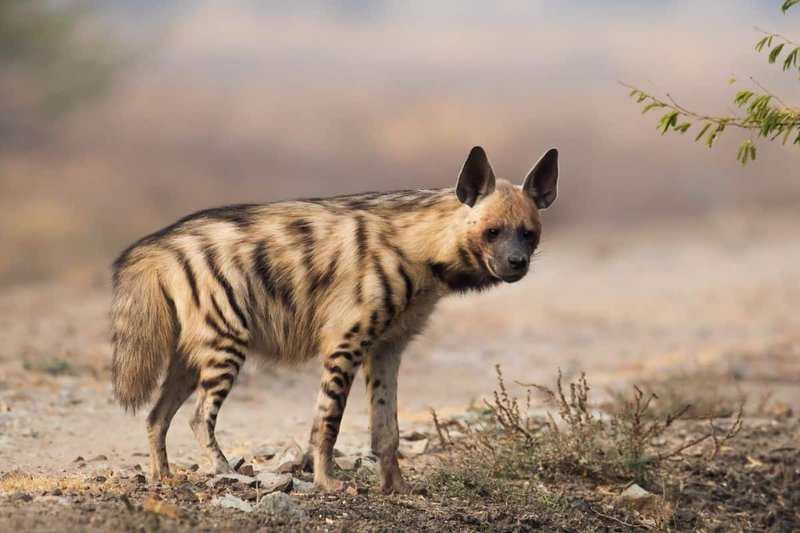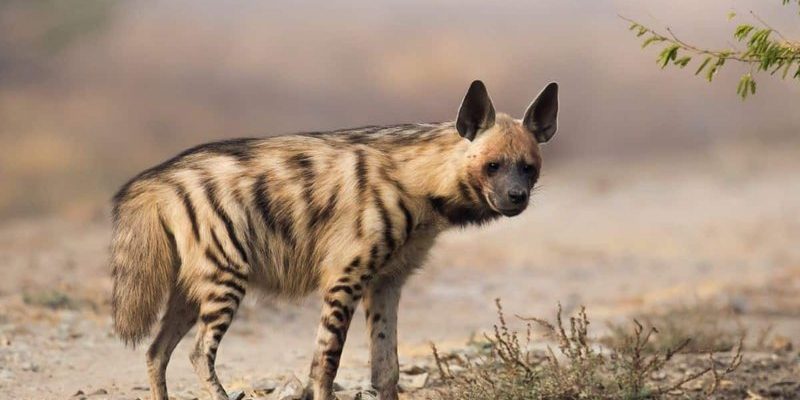
Let’s dive deep into the world of striped hyenas. Imagine sipping coffee while I share some eye-opening facts about these creatures, like their quirky habits, remarkable adaptations, and the challenges they face today. By the time we’re done, you’ll have a better understanding of why these animals are worth our curiosity.
1. Unique Appearance
The striped hyena is easily distinguishable from its more famous relatives. If you look closely, you’ll notice a combination of features that make it both beautiful and bizarre. Its fur is a mix of grey, brown, and black with vertical stripes, making it resemble a mini tiger or a walking shadow. These stripes aren’t just for show; they serve a purpose.
The coloration helps them blend into their environment, especially during the twilight hours when they are most active. Imagine strolling through the dry grass of their habitat and suddenly spotting one—its striped coat almost disappears into the landscape. This provides them with a fantastic advantage while hunting or avoiding predators.
2. Social Structure
You might think of hyenas as loners, but striped hyenas have a different social dynamic. They are primarily solitary, but they do form small family groups. Typically, a family will consist of a mating pair and their offspring. This is where things get interesting—unlike spotted hyenas, striped hyenas don’t have a strict hierarchy.
Instead, these families rely on cooperation. They share food and often communicate through a series of sounds, including growls and whoops. Imagine a small family huddle around a meal, each member taking turns to feed while keeping an ear out for any potential threats. This social behavior adds a charming layer to their otherwise rugged lives.
3. Diet and Feeding Habits
Here’s where striped hyenas really show off their adaptability. Their diet is quite diverse, consisting of carrion, small mammals, fruit, and insects. They are scavengers at heart, which means they often feed on what other predators leave behind. This might sound a little grim, but it plays a crucial role in their ecosystem by helping keep the environment clean.
When hunting, they use their keen sense of smell to locate food. Picture them sniffing the air, their ears perked up, ready to dart off to the source of a scent. They can easily detect carcasses from a distance, which is a pretty impressive skill in the wild.
4. Habitat and Range
Stripe hyenas are primarily found in parts of North and East Africa, as well as the Middle East and the Indian subcontinent. They prefer arid environments, such as grasslands and savannas, where their striped coats can help them blend into the dry grasses.
If you think about the landscapes of the Serengeti or the rocky hills of the Middle East, you can picture where these fascinating creatures roam. They thrive in areas where food is abundant and can be quite resilient despite harsh conditions.
5. Communication Styles
Honestly, if you’ve ever heard a striped hyena, you’d be surprised at how vocal they can be. They communicate through a series of sounds, including whoops, growls, and even a sort of laughing sound, reminiscent of their spotted cousins.
Imagine sitting in the night, surrounded by the sounds of the wild, and suddenly hearing a chorus of strange noises. You’d think you were in a spooky movie! These sounds serve various purposes, such as signaling their presence to mates or warning others of danger. It’s like their own little language, full of nuances.
6. Reproductive Behavior
When it comes to reproduction, striped hyenas have their own charming ways. After a gestation period of about 90-100 days, females give birth to a litter of 2-4 cubs. The playful antics of cubs are truly delightful; they spend their early days learning how to navigate their environment.
Let me explain how this works: the mother instinctively leads her cubs to food and teaches them basic survival skills. You might be surprised to know that the little ones are born with closed eyes, only opening them after about ten days. That’s when they start to explore their world!
7. Conservation Status
Here’s the thing: striped hyenas face several threats to their existence. Habitat loss, hunting, and human-wildlife conflict are significant challenges they must navigate. Despite being classified as Near Threatened, there’s still hope for their survival if we take action.
Conservation efforts are crucial. Organizations are working hard to protect their habitats and educate local communities about the importance of these animals. Imagine a future where striped hyenas roam freely, helping maintain the balance of their ecosystem. That’s the kind of world we should strive for!
8. Myth and Folklore
In many cultures, striped hyenas have made quite an impression, appearing in folklore and mythology. They are often depicted as cunning creatures, sometimes villainized due to their scavenging habits. But let’s take a moment to appreciate their role in the ecosystem instead of looking at them through a negative lens.
In some African cultures, they are seen as symbols of resilience, adapting to survive in harsh conditions. Isn’t it fascinating how our perceptions of animals can shape their narratives? These creatures deserve to be recognized for their ecological contributions and unique characteristics.
9. Comparison to Other Hyena Species
You might be curious about how striped hyenas stack up against their other hyena relatives. Unlike their spotted cousins, who are highly social and live in large clans, striped hyenas prefer a more solitary lifestyle. They also have a more diverse diet, often feasting on a wider variety of foods.
While spotted hyenas are known for their strength and hunting prowess, striped hyenas are the scavengers that play a critical cleanup role. Their differences highlight the diverse adaptations that different hyena species have developed over time.
10. Fun Facts You Might Not Know
To wrap up our journey, here are a few fun facts that might just surprise you about the striped hyena:
- They can run up to 40 km/h (about 25 mph) for short distances.
- Striped hyenas have strong jaws that can crush bones, helping them access nutrients.
- They are nocturnal, meaning they are most active during the night—a perfect time to avoid danger.
- Unlike other hyenas, they often eat fruits and vegetables, showcasing their adaptability.
So there you have it—ten fascinating facts about the striped hyena! From their unique appearance to their vital role in the ecosystem, these creatures are reminders of nature’s complexity and beauty. The next time you hear about hyenas, I hope you’ll think of the striped variety and appreciate their quirky charm. Let’s work together to ensure they continue to thrive and captivate our imaginations for generations to come.

